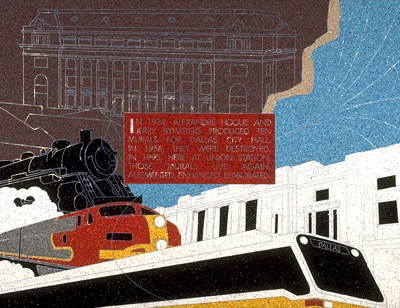

Panel One
This panel serves, in part, as a "legend" for the eleven other murals. It establishes a visual format in which past information, depicted in monochrome, is embellished and expanded with more recent information, shown in color. In each panel, the monochrome layer gives the illusion of "breaking away" to reveal a second image behind it. This dual format is combined with a third layer, a red rectangle in the center of each mural. The rectangles contain quotations that enrich the visual imagery.
The first panel explains the project's genesis. In 1934, Alexandre Hogue and Jerry Bywaters, two respected and accomplished Texas artists, painted ten murals in the old Dallas City Hall. The murals were destroyed in 1954 when the building was renovated and expanded.
The next ten murals each depict Philip Lamb's interpretation of one of the Hogue/Bywaters murals, shown in monochrome, and are augmented with Mr. Lamb's full-color images that relate to the original mural subjects. The twelfth and final panel is a summation of the project.
The monochrome drawing of Panel One depicts Dallas City Hall circa 1934. Below and to the right is a color representation of Union Station in 1995. To the left are three trains representing three generations of rail transportation in Dallas -- a steam engine, a diesel engine, and a DART light rail car. In the sky shown in the upper-right of the piece, seven lines converge into one that winds through the center of the image and overlaps the trains. This represents the function of Union Station when it opened in the early 1900's, to unite seven separate passenger rail stations into one. Symbolically, it represents the union of the Hogue/Bywaters murals with the updated imagery. The quote in this panel reads: "In 1934, Alexandre Hogue and Jerry Bywaters produced ten murals for Dallas City Hall. In 1956, they were destroyed. In 1995, here at Union Station, those murals live again, augmented, enhanced, elaborated."